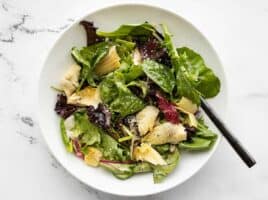
At Belovedsaffron.com we believe that every chef has something unique and delicious to share with their taste buds! If you have any special recipes or would like to contribute an article for our blog section, please don’t hesitate to contact [email protected].
We are devoted to promoting sustainable eating practices that respect cultures worldwide and inspire us with new flavors each day. Let’s work together towards bettering the Earth while enjoying scrumptious dishes!
For now, love yourself and enjoy this one ...
Now love yourself and enjoy this one ...
If you’ve never made a homemade Caesar salad, then you might be surprised by just how easy it is to whip up. Our version includes fresh homemade croutons and a rich and tangy homemade Caesar salad dressing. The simplicity of a Caesar salad is unmatched. It’s simple enough to make during the week and pairs well with lots of main dishes. It’s always my go-to whenever I’m eating out at a nice restaurant, but the truth is…this homemade Caesar salad recipe is wayyy better than any restaurant version. Let me show you just how easy it is to make!
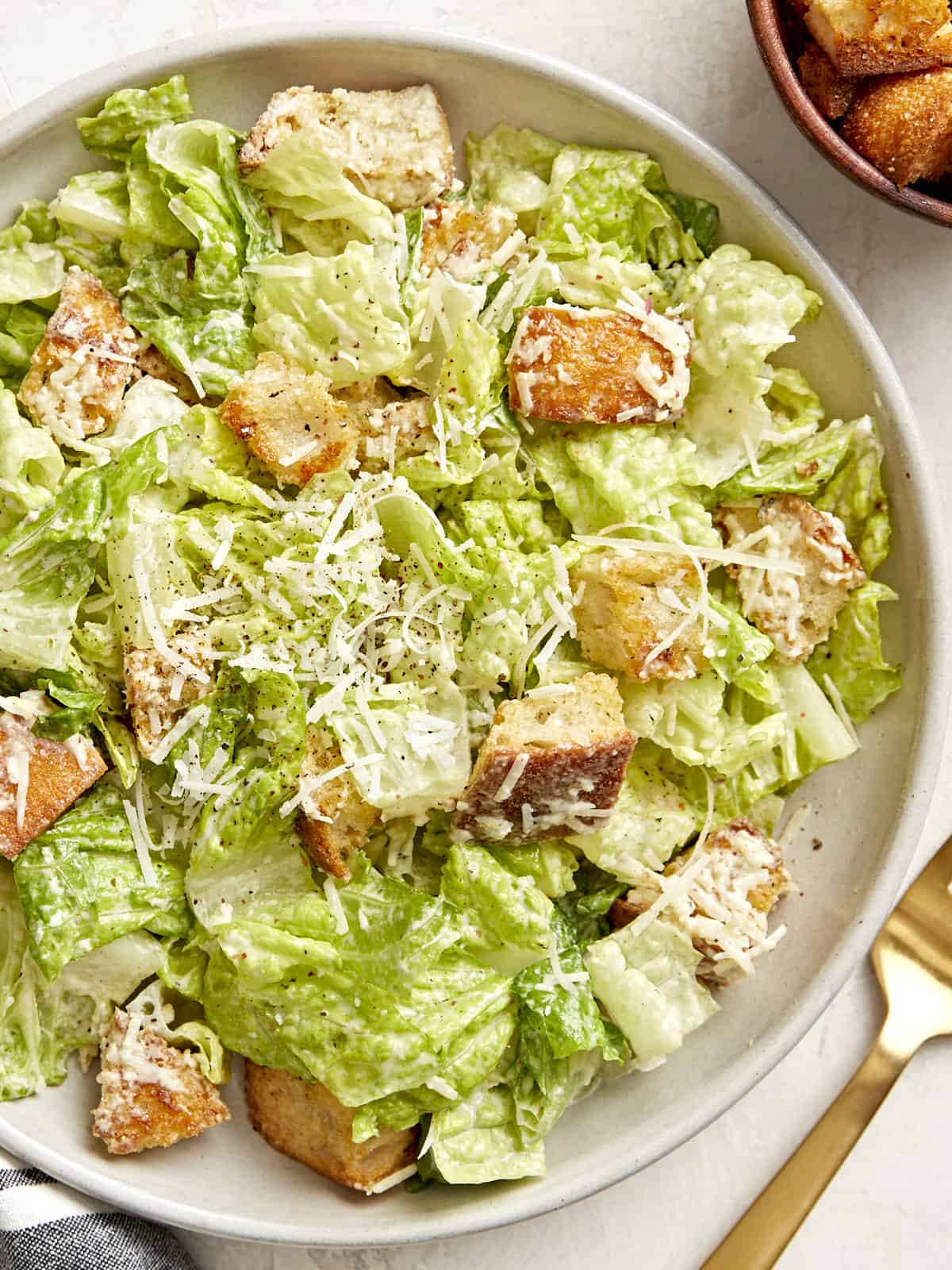
Ingredients For Caesar Salad
All it takes are a few simple ingredients to make this fresh Caesar Salad recipe:
- Romaine Lettuce: Fresh, crisp romaine lettuce is the base of this salad.
- Parmesan Cheese: Since this salad is relatively simple to make with simple ingredients, we spent extra using fresh Parmesan from a Parmesan cheese wedge.
- Homemade Croutons: Homemade croutons are a must friends! They are so easy to make and taste way better than those store-bought ones. Trust me!
- Caesar Salad Dressing: A fresh batch of homemade Caesar salad dressing can be made in hardly no time. But if you are really short on time, you can also use store-bought dressing instead.
Caesar Salad Dressing
Our creamy homemade caesar salad dressing is rich, tangy, super flavorful, and really easy to whip up! And our version is simple thanks to the use of mayonnaise instead of making your own egg and oil emulsion. It includes a combination of lemon, garlic, anchovy filets, Dijon mustard, mayonnaise, Parmesan, and freshly cracked black pepper. It has lots of complex flavors and tastes absolutely delicious with this Caesar salad!
Easy Homemade Croutons
The real key to any great Caesar salad, imo, are homemade croutons! Ok, second to the dressing of course :) They’re crispy, crunchy, and oh-so-flavorful! And the best part is…they’re super easy to make! We made a quick batch of our Easy Homemade Croutons recipe with some crusty bread, olive oil, and seasoning. That’s it! Trust me, it will take your salad to the next level, so don’t skip it!
What To SErve with Caesar Salad?
One of the best ways to enjoy this simple caesar salad is by adding some grilled chicken, Pan Seared Chicken, or Air Fryer Chicken on top for a quick and easy chicken caesar salad. Salmon and shrimp also taste great with this salad! Or simply add this salad as a side dish along side your favorite dinner recipes like Homemade Lasagna or Creamy Garlic Chicken.
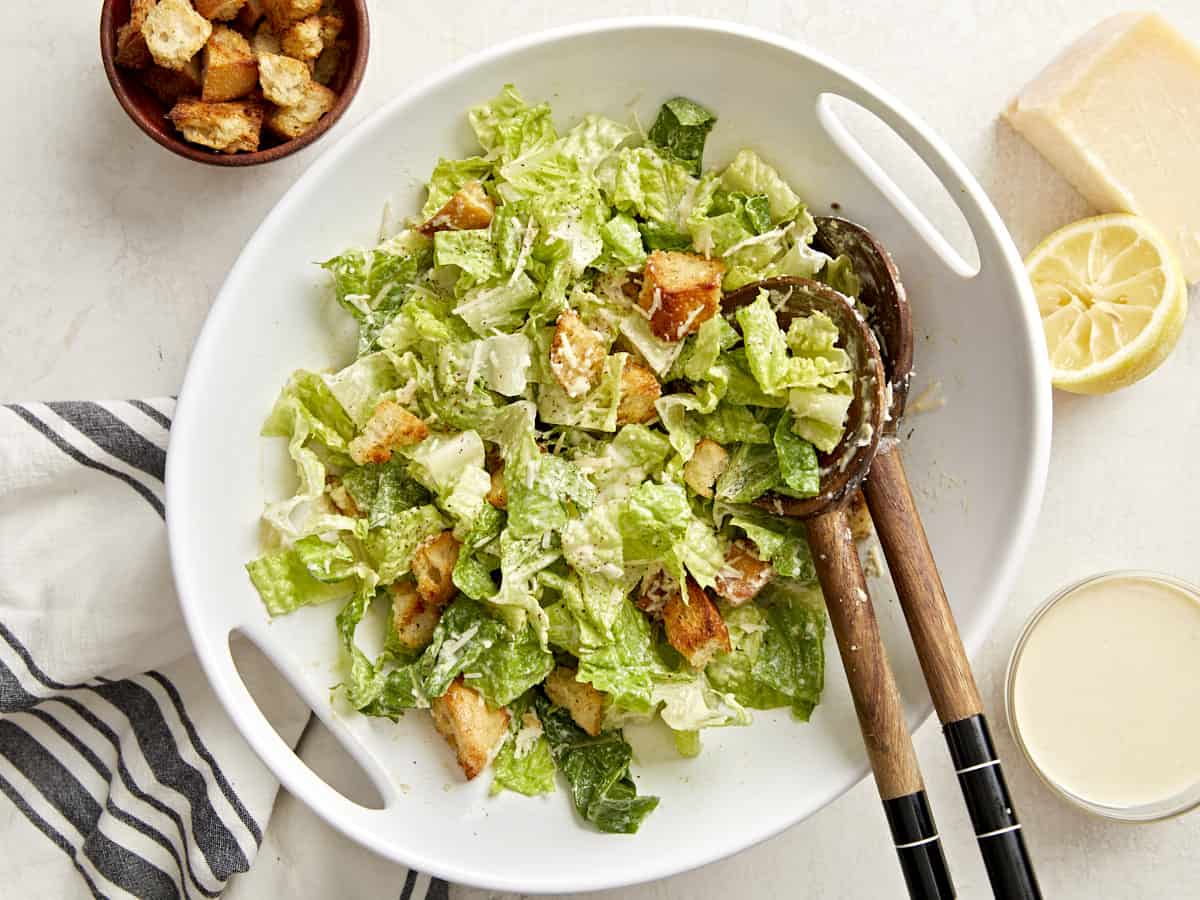
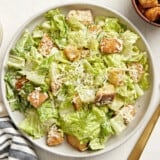
Caesar Salad
Ingredients
Caesar Salad Dressing
- 1 fresh lemon $0.79
- 3 cloves garlic $0.24
- 3 anchovy filets (packed in oil) $0.86
- 1/4 tsp freshly cracked black pepper $0.02
- 2 Tbsp Dijon mustard $0.20
- 1/2 cup mayonnaise $0.66
- 1/4 cup grated Parmesan $0.40
Salad
- 8 cups chopped romaine lettuce $3.73
- 2 cups croutons $0.71
- 1/2 cup shredded Parmesan $0.89
Instructions
- Start by making the Caesar salad dressing. Zest and juice the lemon. You'll need about 3 Tbsp juice and 1 tsp lemon zest. Finely mince the garlic and anchovy filets. Reserve about ½ tsp of the oil from the anchovy container.
- In a medium bowl add the lemon juice, zest, minced garlic, minced anchovies, anchovy oil, and pepper. Whisk to combine.
- Add the Dijon mustard, mayonnaise, and grated Parmesan to the bowl and whisk to combine again. Taste the dressing and adjust the ingredients to your liking.
- Next chop, wash, and dry the Romaine lettuce. Add the lettuce to a large bowl.
- Top the lettuce with the croutons, shredded Parmesan, and half of the Caesar salad dressing (start with half the dressing and add more as needed). Toss the salad until everything is coated in the dressing. Serve with extra Parmesan cheese and freshly cracked black pepper on top. Enjoy!
See how we calculate recipe costs here.
Nutrition
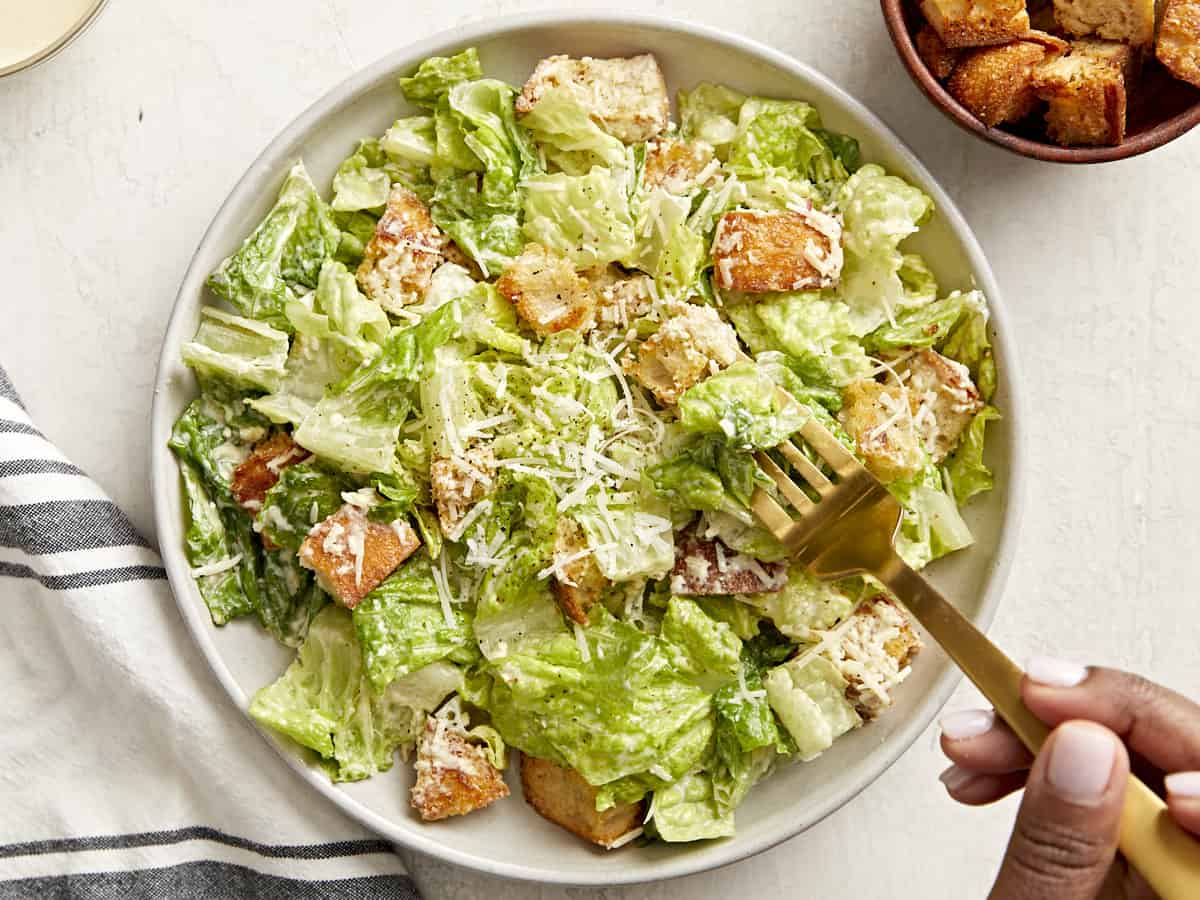
How to Make A Caesar Salad - Step by Step Photos
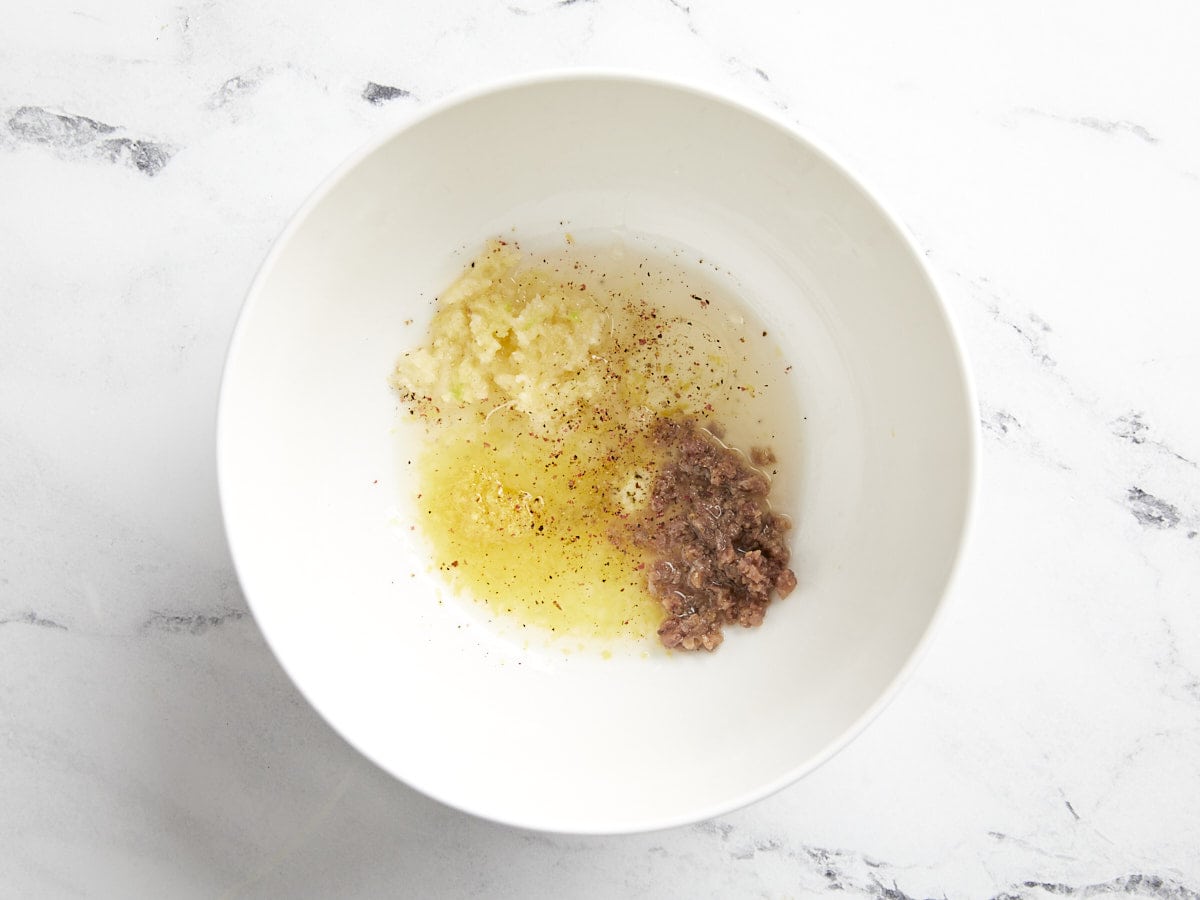
Start by making the Caesar salad dressing. Zest and juice 1 lemon. You’ll need about 3 Tbsp juice and 1 tsp lemon zest. Finely mince 3 cloves of garlic and 3 anchovy filets. Reserve about ½ tsp of the oil from the anchovy container.
In a medium bowl add the lemon juice, zest, minced garlic, minced anchovies, anchovy oil, and 1/4 tsp pepper. Whisk to combine.
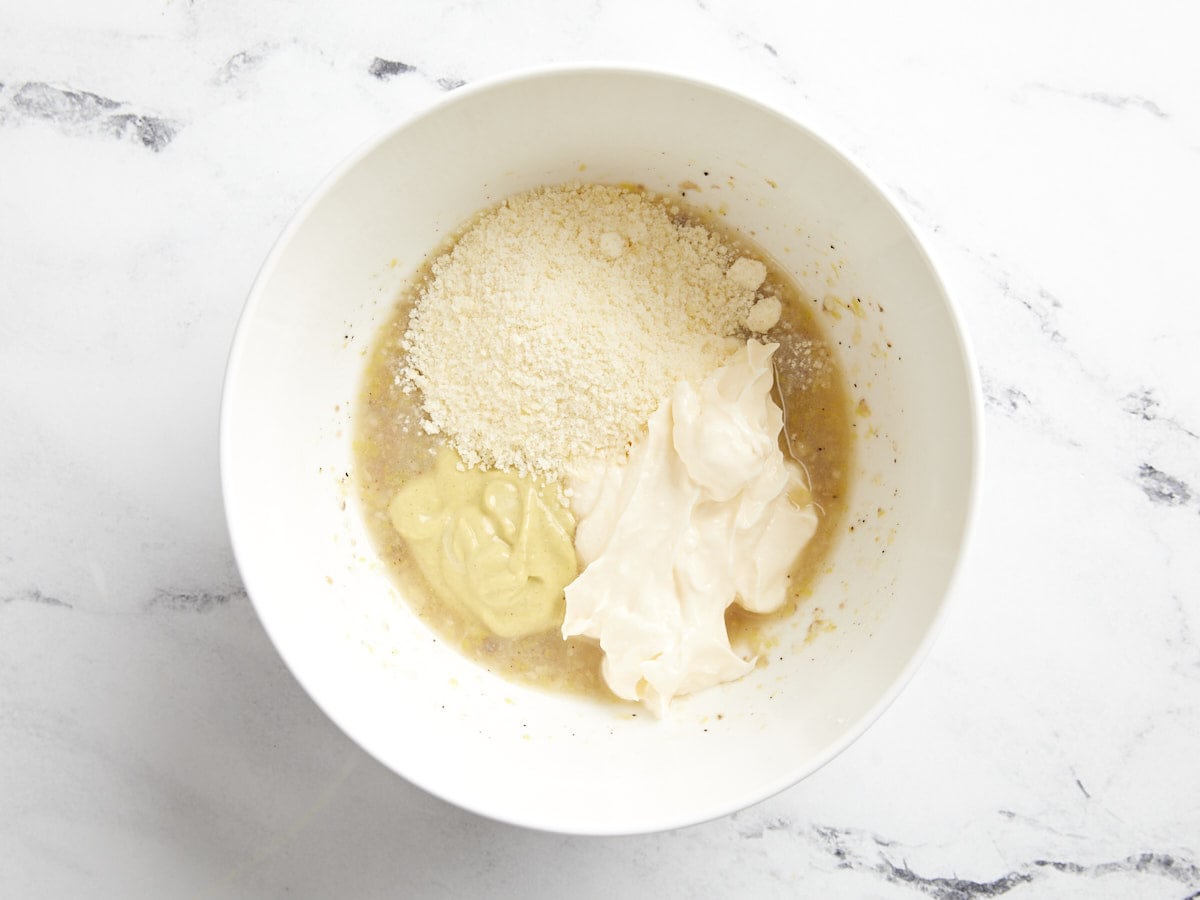
Add 2 Tbsp Dijon mustard, 1/2 cup mayonnaise, and 1/4 cup grated Parmesan and whisk to combine again.
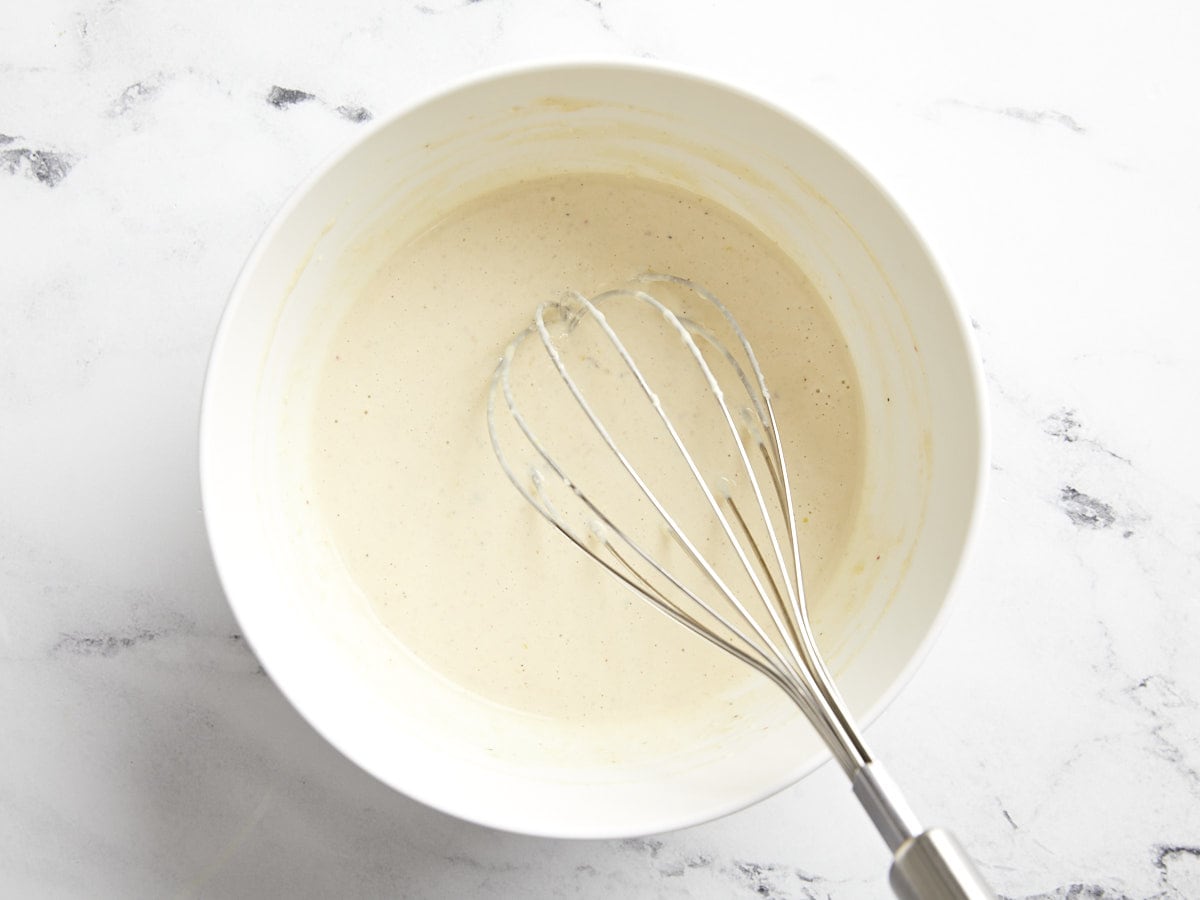
Taste the dressing and adjust the ingredients to your liking.
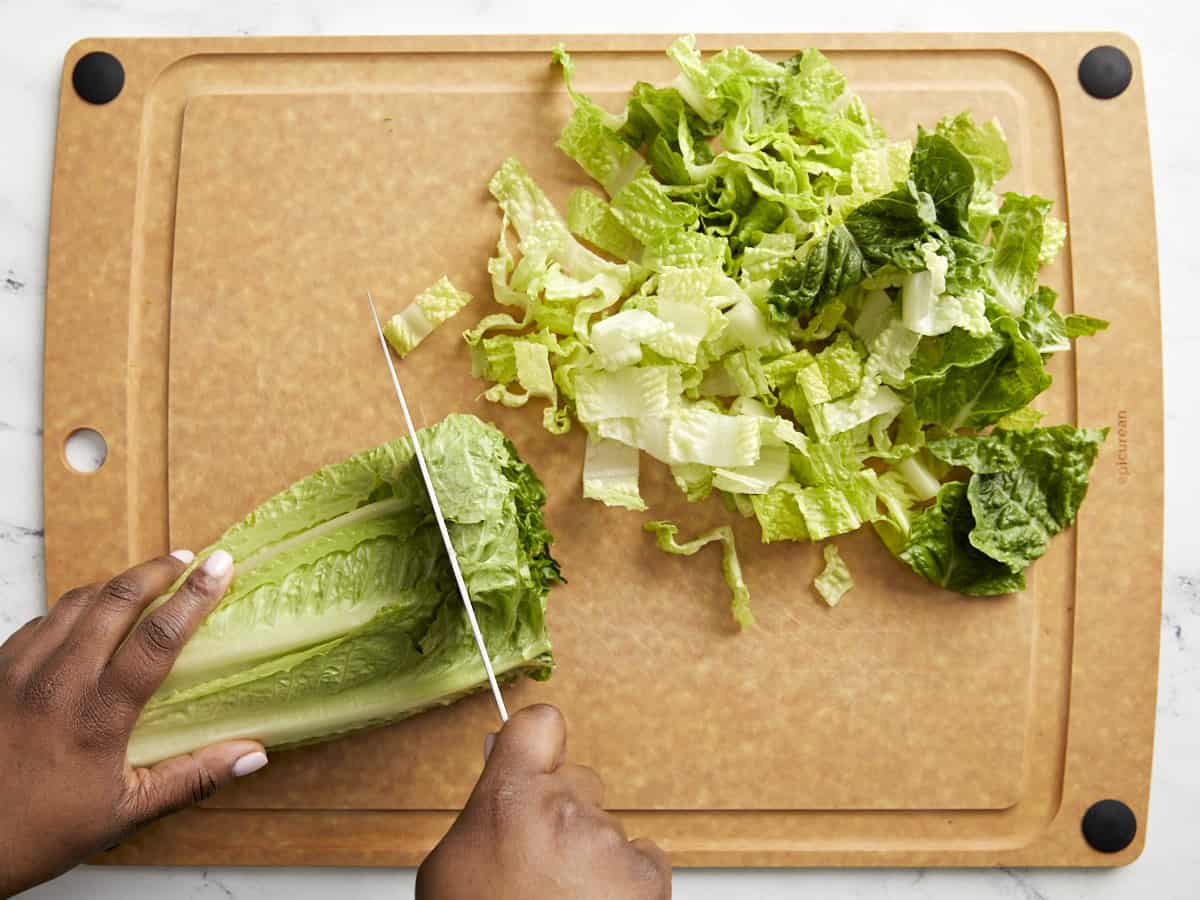
Next chop, wash, and dry 8 cups of Romaine lettuce. Add the lettuce to a large bowl.
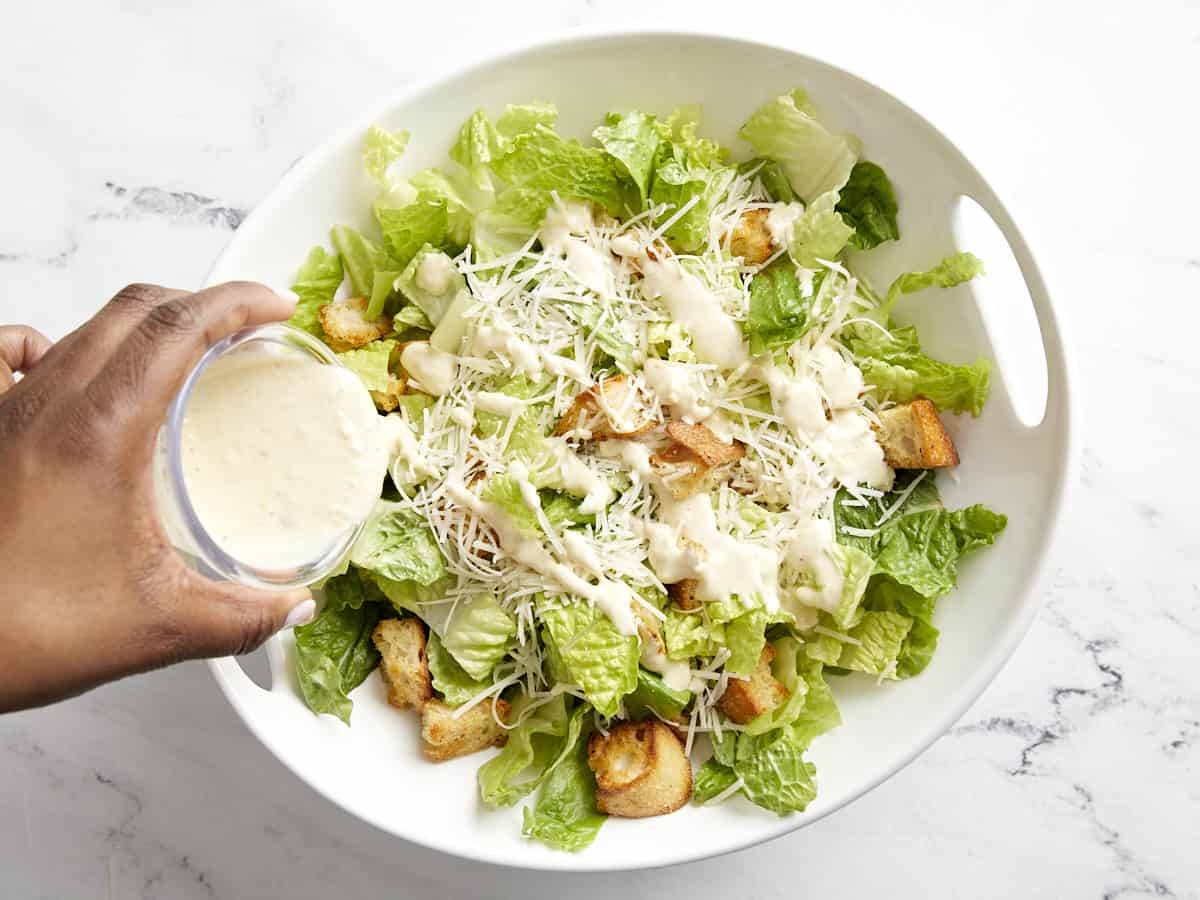
Top the lettuce with 2 cups croutons, 1/2 cup shredded Parmesan, and half of the Caesar salad dressing (start with half the dressing and add more as needed).
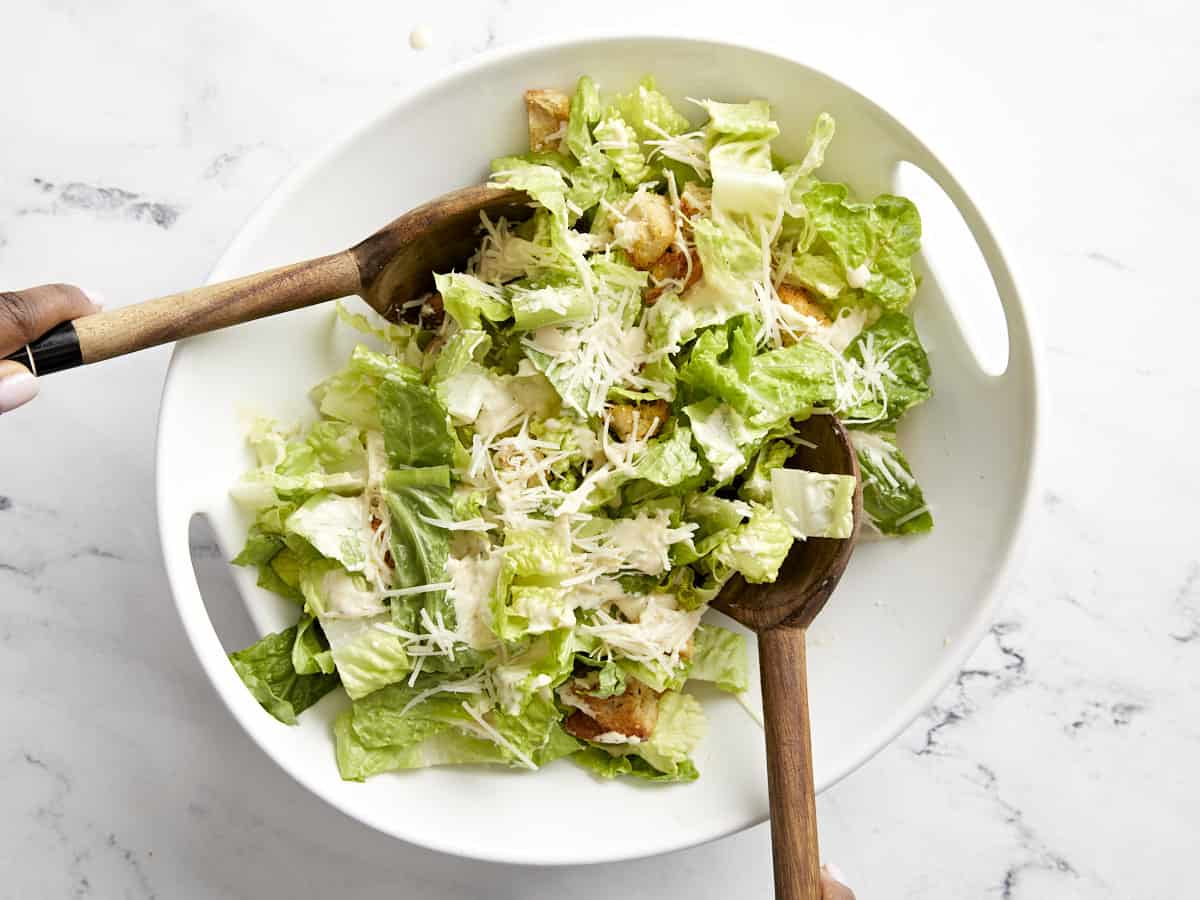
Toss the salad until everything is coated in the dressing.

Serve with extra Parmesan cheese and freshly cracked black pepper on top. Enjoy!
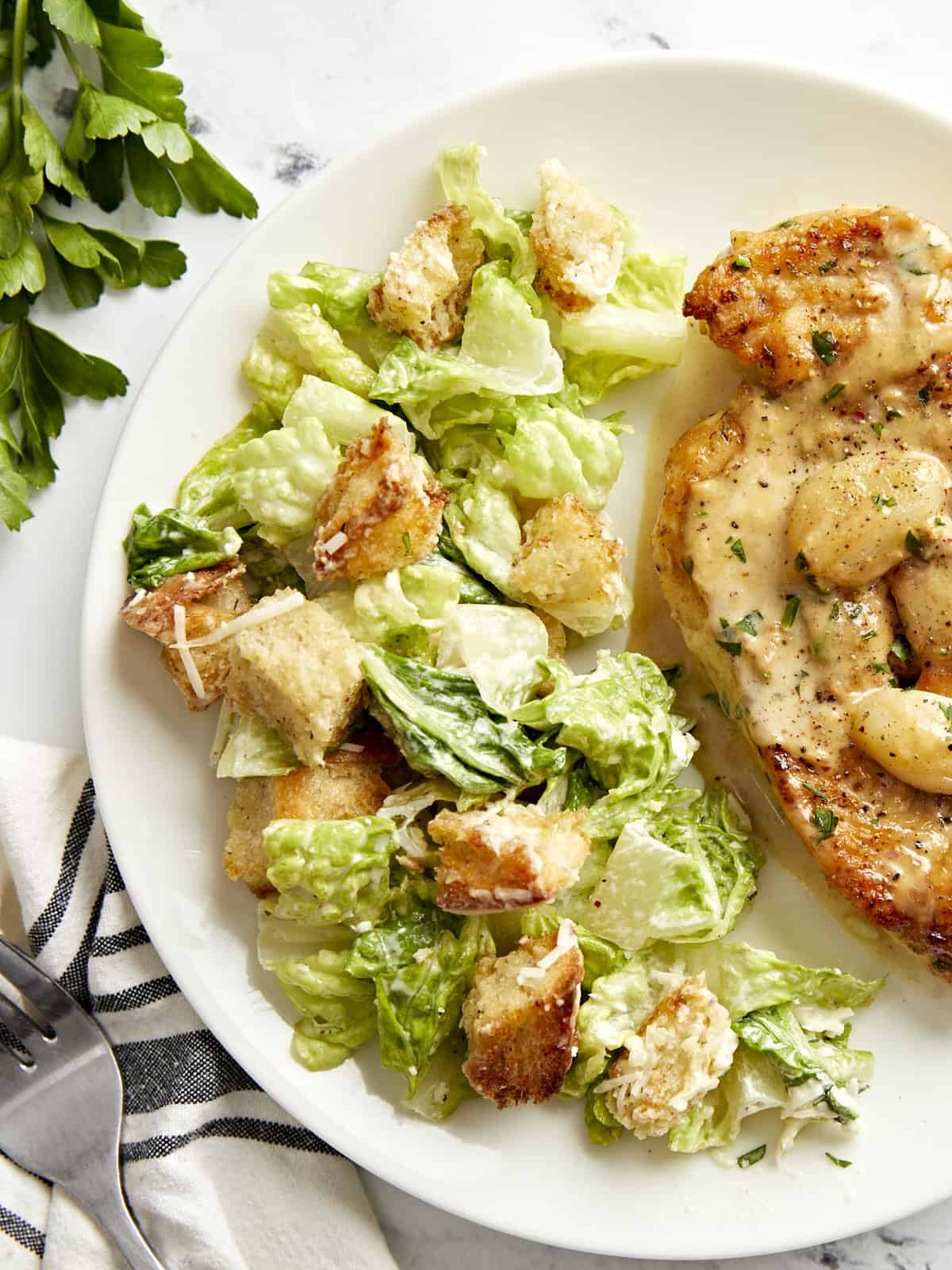
*Pictured with our Creamy Garlic Chicken
More Easy Salad Recipes

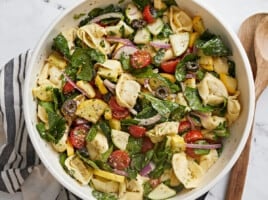
Tortellini Salad
$15.57 recipe / $1.30 serving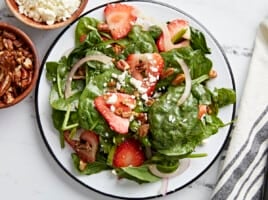
Strawberry Spinach Salad
$8.72 recipe / $2.18 serving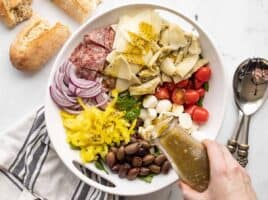
Antipasto Salad
$16.92 recipe / $2.12 servingThe post Caesar Salad appeared first on Budget Bytes.
References:
By: Marsha - Budget BytesTitle: Caesar Salad
Sourced From: www.budgetbytes.com/caesar-salad/
Published Date: Mon, 18 Mar 2024 14:00:00 +0000
Frequently Asked Questions
Why is organic foods important?
It is essential for our health to eat organic produce. It's the best method to ensure you eat healthy foods. Not only is it better for us, but it's also more environmentally friendly because it doesn't rely on pesticides and fertilizers.
Organic farming uses natural methods of cultivating crops that are free from harmful chemicals. This means fewer environmental pollutants, making it safer for humans and animals. So when you choose organic food, you're helping to protect yourself and the planet.
However, organic food is good for our health. We are all well aware of how harmful processed food can make our bodies feel. However, organic fruits & vegetables aren’t treated with chemical sprays. It means that organic fruits and vegetables taste better, last longer, and are brighter.
This is why organic food is so important. Because it's not only healthy for you, it's healthier for the world.
Does organic mean it is pesticide-free?
Organic food is organic and free of pesticides. This means organic food is free from pesticides and fertilizers.
Because organic produce does not contain harmful additives it has more nutrients that conventionally produced foods.
The USDA National Organic Program, (NOP), requires farmers to adhere to strict guidelines when cultivating organic crops.
These guidelines include soil preparation, crop rotation, pest control, water conservation, and harvesting practices.
Organic farming methods are also beneficial for wildlife and natural habitats.
What is an organic food processor?
Organic food producers use organic methods to grow their products. These foods include fruits and vegetables, grains, as well as dairy products.
Organic food production is only possible on farms where the crops are grown naturally. This includes soil preparation, pest control, and crop rotation.
To be organic, an agricultural product must meet the strict criteria of USDA (United States Department of Agriculture).
These guidelines are designed to ensure consumers have access to safe, healthy and nutritious food.
Organic foods offer many health benefits. They are free from heavy metal contamination and pesticide residues. They also have higher nutritional content and better taste.
USDA Organic Products must have the "USDA Certified organic" label.
This certification indicates that the product meets the requirements of the National Organic Program.
Organic food not only makes us healthier but also helps to protect the environment.
Organic farming techniques help preserve natural resources such as water and land. Organic methods also reduce greenhouse gas emissions that can cause climate change.
Organic agriculture uses less chemicals and reduces the amount of pollution runoff.
It improves air quality as harmful gases such nitrates or ammonia are less likely to accumulate in the atmosphere.
There are many kinds of organic farming: permaculture, regenerative and conventional.
Conventional agriculture refers to the use synthetic inputs, such as pesticides/fertilizers.
Regenerative farming uses compost, cover crops, green manures, and other methods to improve the soil's health. It promotes biodiversity.
Agroecology focuses on sustainable relationships between people, plants, and animals.
Permaculture is a system that mimics nature and promotes self-sufficiency.
What are the most loved organic products?
Today, organic foods are the fastest-growing industries. Even though we have come a long ways from our roots there is still plenty of room for growth.
Organic products are the future. Organic products are safer, more sustainable, and cheaper for consumers.
But they also tend to be higher priced. We created the Organic Food Index. We wanted the ability to identify which foods are currently most popular and whether these trends have changed.
These findings show that organic foods are becoming more popular. Between 2011 and 2012 the number of Americans buying organic food increased nearly 50%.
According to USDA, organic production grew by 10% last year. The U.S. now produces 9% of its agricultural output from organic food.
Organic food is certainly on the rise but consumers are still not able to afford it. The Organic Trade Association (OTA) reports that organic food retail prices average almost double the price of conventional foods.
That said, organic food is growing faster than any other segment of the food sector. Looking closely at the data, you'll see that organic food consumption has grown steadily since 2009.
According to OTA the volume of organic products sold at supermarkets grew by 14% in 2010 and 2011.
This is because of consumer demand for healthier products, which explains the rise in organic food sales across all age categories.
Younger generations are choosing organic food more often than older generations. Millennials are twice likely to choose organic food than the baby boomers. And young adults under 35 years old account for 25% of all organic food purchases.
How do you know if your food is organic?
Ask any chef and he will tell you that fresh ingredients are the most important thing. Because we feel better when we eat well.
The same applies to our food. Organics can be traced back to their source and whereabouts. We also know that organics were not treated with harmful chemicals.
Organic foods are produced without using synthetic pesticides, fertilizers, hormones, antibiotics, or genetically modified organisms (GMO). These substances are not allowed for organic farmers.
There is no art in growing organic crops. There are many safe ways to grow them.
Sometimes, organic farming is called sustainable agriculture. This means that while it uses fewer resources than conventional methods, it provides the necessary nutrients to sustain life.
Organic farming practices include crop rotation, composting manure, cover cropping, and intercropping. These techniques help prevent soil erosion and improve water quality.
They also reduce chemical runoff into waterways. Since most of us live in urban areas, we can find local farms that raise organic produce.
There are two types of certification programs for organic products. The USDA National Organic Program certifies the one while the independent certifying agency certifies the other. Both require strict adherence to organic standards.
Certified organic products may bear the USDA seal or the symbol O Seal, which indicates that the product meets federal requirements.
Statistics
- Nutrients like omega-3 fatty acids were up to 50 percent higher in organic meats and milk than in conventionally raised products.[3] (en.wikipedia.org)
- Brands participating in this challenge are committed to using 100 percent sustainable cotton by 2025.[5] (en.wikipedia.org)
- According to a study performed by consumerreports.org, organic products, compared to non-organic products, ranged anywhere from 13 percent cheaper to 303 percent more expensive. (en.wikipedia.org)
- As for organic meat, regulations require that animals be raised in living conditions that accommodate their natural behaviours (like the ability to graze on pasture), fed 100% organic feed and forage, and not administered antibiotics or hormones. (usda.gov)
External Links
[TAG40]
[TAG42]
- The impact of organic food on human health: Assessment of the status quo, prospects for research - ScienceDirect
- Technical note: Simultaneous Vitamin and Carotenoid Analysis of Milk from Total Mixed Ratio-Fed Cows - ScienceDirect
[TAG45]
[TAG47]
How To
Five Reasons to Purchase Organic Products
Organic foods do not use pesticides or synthetic fertilisers. They contain no genetically modified or irradiated food ingredients. Their production methods do not involve sewage sludge or industrial solvents. The food's natural environment is protected from contamination during its growth cycle. It does not contain artificial preservatives or additives. There is no use hormones or anti-biotics. They are also grown in conditions that ensure they retain their nutritional value for longer periods of time.
- Health benefits. Organic produce contains less chemicals than nonorganic. This means that organic produce is less likely cause allergic reactions and sensitivities. You also consume fewer toxic substances and carcinogens.
- Eco-friendliness. Produce grown without pesticides and synthetic fertilizer requires very little water. Because conventional farming requires so much energy, organic farms are usually located far from places where pollution is high. This helps reduce pollution.
- Sustainability. Organic farming relies more on soil fertility than chemical fertilizers. This results is healthier soils with higher organic matter. The rotation of crops and the letting of land fallow can improve soil health. Farm animals that eat only grasses, grains and no antibiotics develop strong immune systems.
- Taste. Traditional fruits and vegetables are often bland due to the fact that they are picked at peak ripeness and shipped long distances for grocery stores. Organic produce tastes sweeter and more rich because it was picked when it was still young.
- Nutrition. Many conventional processed foods contain harmful substances like BPA and GMOs. These harmful substances can be avoided by sticking to whole foods like meat, eggs, fish and nuts as well as seeds, beans, fruits, vegetables, and herbs.
 |
[TAG50]This Irish-inspired colcannon soup is easy to make with creamy potatoes, kale and cheddar cheese. The last time I made colcannon (traditional Irish mashed |
 |
[TAG51]This Irish kale colcannon recipe is perfectly buttery and fluffy and easy to make with a handful of basic ingredients. St. Patrick’s Day is just around the |
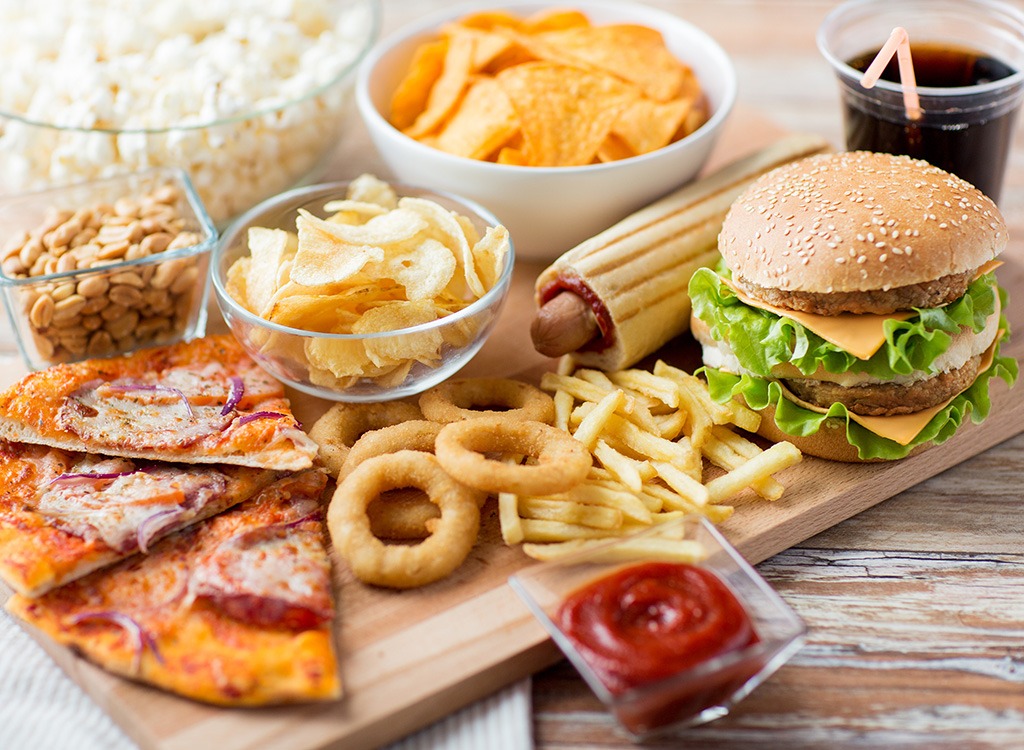 |
[TAG52]Easy to make full flavoured recipes. Life is too short for boring food! |
 |
[TAG53]Hello hello! Just wanted to pop in with a cute little life update. ♡ I’m delighted to share that our sweet son, Milo Alexander Martin, came to join our family |
 |
[TAG54]This vibrant lemony broccoli pesto pasta is quick and easy to make and full of fresh flavors. Your veggies, greens, and pasta…all in one gorgeous dish! ♡ We’re |
 |
[TAG55]HEALTHY & KID-FRIENDLY MEALS easy dinner recipes made in minutes. The Latest Recipes st. Patrick's Day Recipes Hello! I'm Sara! Welcome to Dinner at the Zoo! |
 |
[TAG56]This simple roasted carrot soup recipe is made with creamy tahini and topped with crispy za’atar chickpeas. Naturally gluten-free, vegetarian and vegan. If you |
 |
[TAG57]My longtime favorite flourless cake recipe is decadently rich and delicious, naturally gluten-free, and easy to make in under 1 hour! Trust me, this flourless |
 |
[TAG58]From comfort foods to indulgent dishes browse hundreds of recipes that your family will love and make over and over again. Cooking Classy has never been easier, |
 |
[TAG59]This vegetarian cabbage roll soup is filled with protein-rich lentils and all of the delicious flavors you love from traditional cabbage rolls. Naturally |
 |
[TAG60]These zesty roasted sweet potato and chickpea bowls are layered with sautéed spinach and brown rice and tossed with my favorite 4-ingredient chipotle tahini |
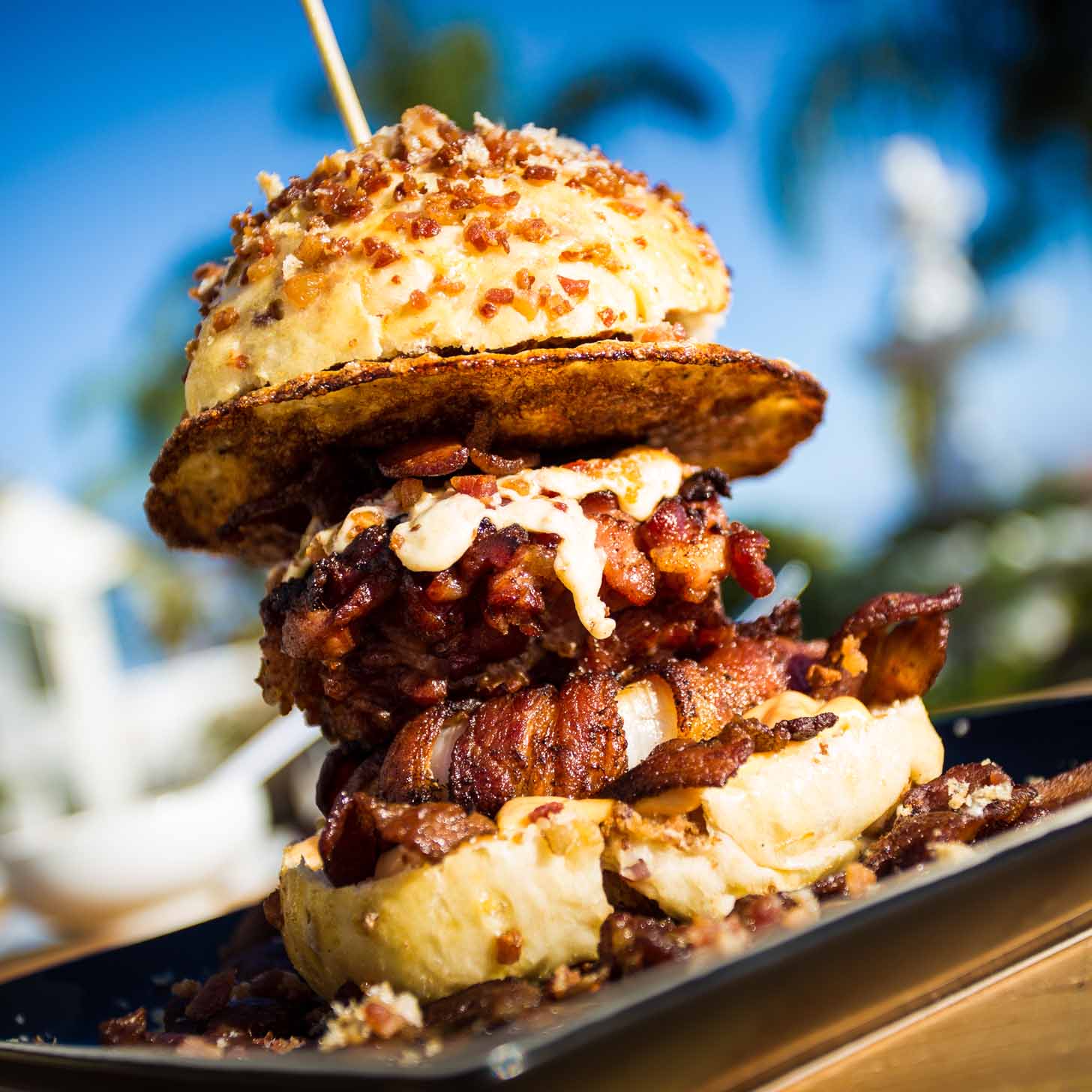 |
[TAG61]A family food blog with hundreds of simple, tested and approved recipes. Find easy step-by-step photo cooking instructions and video recipes. |
 |
[TAG62]This classic matcha latte recipe is easy to make and customize to your liking and always so delicious. The older I get, the more I’m convinced that one of |
 |
[TAG63]This veggie-loaded broccoli cheese soup recipe is perfectly velvety and creamy without using heavy cream. Instant Pot, Crock-Pot and stovetop options all |
 |
[TAG64]find out hundres of delicous food recipes |
 |
[TAG65]This winter farro salad recipe is made with the most delicious blend of seasonal fruit, greens, nuts, crumbled cheese and tossed with a vibrant orange ginger |
 |
[TAG66]This lovely white wine sautéed mushrooms recipe is quick and easy to make, full of rich savory flavors, and can pair well as a side dish with many different |
 |
[TAG67]The food blog with mostly healthy recipes made with real, whole foods inspiring more people to get into the kitchen and cook something good. |
 |
[TAG68]This traditional Swedish meatballs recipe is bursting with rich, savory flavors and topped with a creamy gravy. Always so comforting served over mashed |
 |
[TAG69]A food blog with hundreds of quick and easy dinner recipes. Classics done right, incredible one pot recipes, Asian takeout at home and holiday feasting! |
.png)





